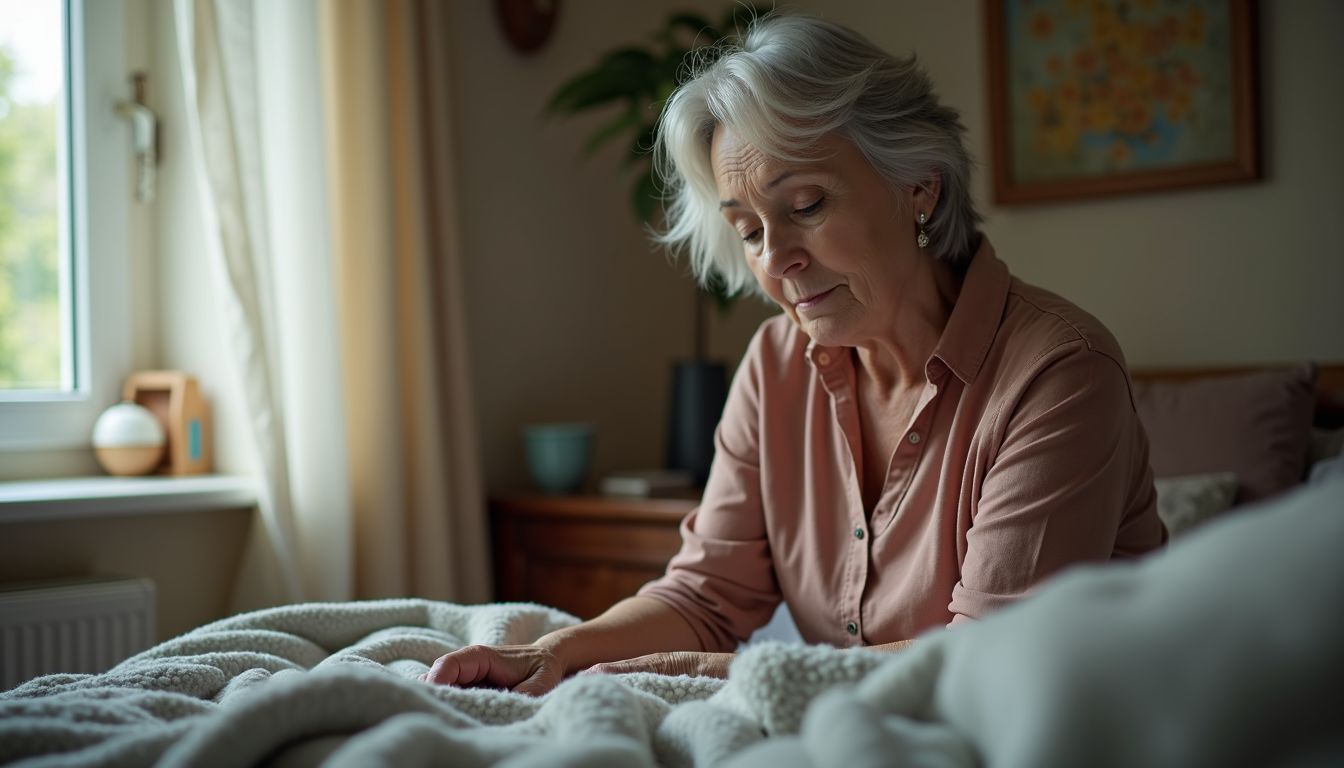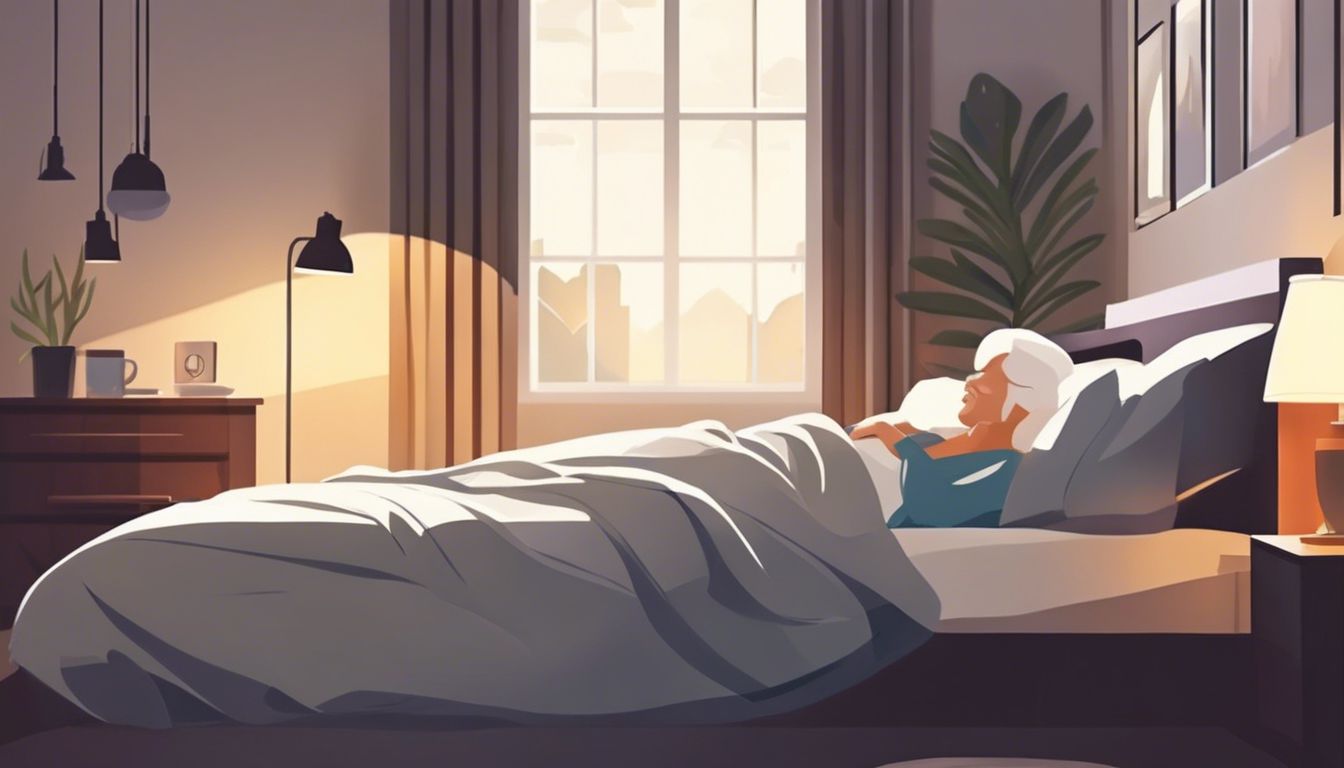Designing a bedroom for caregivers isn’t easy. One fact stands out: ground floor rooms aid seniors by avoiding stairs. This article will show you how to make these bedrooms safe and comfy.
Read on–it helps a lot.
Key Takeaways
- Pick a ground floor room to help avoid stairs and make it easy for everyone.
- Use beds that move and floors that don’t slip to stay safe and comfy.
- Lots of light helps, and smart tech makes caring easier.
- Keep the bedroom simple with less stuff to move around better.
- Choose calm colors for the walls and strong furniture that lasts long.
Choosing the Right Location in the Home

Picking the right spot for a caregiver’s room is key. A place on the ground level and away from noise helps with both movement and sleep.
Ground Floor for Accessibility
A ground-level bedroom simplifies life for all concerned, eliminating the requirement for stairs. If this isn’t feasible, a stair lift becomes a compelling alternative. Flooring must be level and smooth to facilitate walking or the use of wheelchairs, and doorways should be a minimum of 36 inches wide to allow easy wheelchair access.
The importance of natural light and fresh air cannot be overstated. Contemplate the installation of large windows or even a skylight to invite sunshine and airflow. This kind of setup brightens the room and maintains the temperature, courtesy of an efficient heating and air conditioning system.
This configuration lessens the mobility challenges for caregivers, allowing them to concentrate more on providing care.
Quiet Area to Promote Rest
Choose a bedroom spot away from noise to help the caregiver and those in their care sleep better. Noise can make resting hard, so a quiet room is key for good sleep and health. A place with less traffic and further from street noise is ideal.
Make sure it’s a space where sounds from TVs or kitchens do not reach easily.
A calm environment leads to better rest.
For ventilation, use quieter HVAC systems that won’t disturb sleep while keeping the room comfortable. Reliable heating and cooling are important for a restful area, especially for someone with chronic conditions who needs stable temperatures.
Think about adding slip-resistant flooring here too—it makes getting up at night safer without adding noise like harder floors might do.
Essential Bedroom Features for Caregivers
Caregivers need bedrooms that ease their work and keep them safe. Think adjustable places to sleep, floors that stop slips, and lights everywhere for clear sight.
Adjustable Beds for Comfort and Safety
Adjustable beds are key for comfort and safety in a bedroom. They let people change the bed’s height to between 25 and 36 inches. This is perfect for getting in and out of bed easily.
Some beds use electricity or hydraulics to move. They can also have railings on the side. These railings keep people safe from falling.
These beds make sure everyone sleeps well and stays safe. Caregivers find them helpful because they can adjust the bed to do different tasks better, like reading or using mobile devices.
Also, having a bed that moves helps prevent sores from lying down too long. Making these changes is easy with just a push of a button, making life simpler for both the caregiver and the person they look after.
Slip-Resistant Flooring to Prevent Falls
After adjusting the bed to ensure comfort and safety, it’s vital to focus on the floor. Slip-resistant flooring helps prevent falls. It is especially important because hard floors can be very slippery.
Adding safety strips makes these surfaces safer to walk on. Also, fixing mats securely and flattening rug edges are key steps to stop tripping.
Avoiding deep pile carpet or ones that are loose or worn out is a smart move. This ensures everyone moves safely in the room, reducing risks of falls and injuries.
Ample Lighting for Visibility and Safety
Good lighting keeps the bedroom safe at night. Touch-activated bedside lamps turn on easily. Motion-sensor lights under the bed light up when someone moves. We lower light switches to 44 inches off the floor so everyone can reach them.
Next, we look at how to make more room for easy moving around.
Optimizing Space for Efficiency
Making a bedroom work well means thinking smart about space. Clear out big chairs or desks and bring in voice-controlled devices and wall shelves to keep things neat and easy to get.
Minimize Furniture for Easier Mobility
Keep only the necessary furniture in the bedroom. This makes moving around easier for everyone. A bed, a nightstand, and maybe a chair are enough. Too much stuff can cause falls or block paths.
For storage, use walls—shelves hold many things without taking up floor space.
Use dividers or temporary walls to make more room if needed. These can help split areas for different uses without permanent changes. Talk with design experts to find the best ways to save space and keep the room safe and easy to use.
Smart Technology Integration for Monitoring and Control
Smart technology makes taking care of someone easier. Devices like IoT sensors let you watch over them without being in the room. For example, with automated window coverings, you can control light from anywhere.
This means more comfort for them and less worry for you.
PalCare Motion Sensor helps check on the person without disturbing them. If they fall, SafelyYou sends an alert to prevent serious injury. Falls are common but these tools cut down the risk by a lot.
Next, look into efficient storage solutions to use space well.
Efficient Storage Solutions to Maximize Space
Use shelves and cabinets that touch the ceiling. This uses all the room height, not just part. It keeps stuff off the floor too. Put things you rarely use on top shelves. Keep everyday items lower where you can easily get them.
Label drawers and bins clearly for quick finds. Store cleaning supplies, medications, and equipment in locked drawers or cabinets for safety. This makes sure dangerous items are out of reach but ready when needed.
Use dividers inside drawers to keep small items organized and easy to grab.
Personalizing the Bedroom
Making the bedroom feel like home is key. Choose soft, calm colors and comfy furniture that lasts long. Add some personal items to make it special. Keep reading!
Selecting Calming Colors for a Soothing Environment
Cool blues, greens, and natural tones make a room feel calm. These colors help people relax. For those with memory care needs, it’s best to avoid dark colors. A bedroom should feel like a safe place to rest.
Adding nature-themed artwork brings more peace and feels good.
Adding cool blue or green colors can turn any room into a peaceful haven.
Smart lighting helps control the mood in the room too. It can change brightness or color based on what you need. This makes sure the bedroom is always comfortable for resting or waking up gently in the morning.
Durable Furnishings that Offer Comfort and Longevity
Choosing strong furnishings matters a lot. Go for pieces made of materials like veneer, thermolaminate, and laminate. These stand up to lots of use and keep looking good. Veneer fights off water, making it top choice in busy spots like nursing homes.
Thermolaminate is tough; it’s perfect where extra care is needed, such as Memory Care areas. For those watching their budget, high-pressure laminate tops last long without costing too much.
Each piece needs to mix well with daily life and healthcare gadgets. Think about cases that can hold medical tools or spaces designed for personal protective gear. Furniture should be easy to clean yet cozy enough for long hours spent sitting or resting.
It’s all about finding the balance between hard-wearing surfaces and the need for a warm, inviting space.
Accessories that Reflect Personal Tastes and Needs
Brighten the bedroom with accent lighting and decorative pillows. Use organic window treatments for a natural touch. Add life with green plants. Make sure there’s a functional phone with big, backlit keys for easy use.
Think about fun touches too, like robotic pets or virtual reality tools. These can offer joy and relaxation. It’s all about creating a space that feels good to be in.
Next up, let’s talk about using tech smartly in the room…
Utilizing Innovative Technology
In a caregiver’s bedroom, smart technology makes life easier. Think of wearing devices to track health and apps on phones or tablets for talking and fun.
Wearables for Health Monitoring
Wearables for health monitoring are tools caregivers can use every day. These devices, like smartwatches and fitness trackers, keep track of heart rates, sleep patterns, and steps taken.
They make it easy to watch over someone’s health without being too intrusive. Caregivers can get alerts if there’s a sudden change in the person they’re looking after. This way, they know right away if there’s a problem.
Smart technology in wearables also means caregivers can share information with doctors quickly. This helps everyone stay on the same page about the person’s health needs.
Using wearables for health monitoring gives peace of mind to both caregivers and those they care for.
Next up is exploring how smartphones and tablets entertain and connect us.
Smartphones and Tablets for Communication and Entertainment
Smartphones and tablets keep caregivers connected. They use these gadgets to talk with doctors and family fast. Entertainment is easy too. These devices hold apps for movies, music, and games.
Caregivers can relax or have fun during breaks.
LED TVs are perfect for watching shows and films in the bedroom. The best sizes are between 40-43 inches for a clear view without taking up much space. Strong Wi-Fi makes sure streaming on laptops, smartphones, and tablets is smooth.
This setup helps caregivers stay happy and informed right from their room.
Environmental Controls via Automated Systems
Automated systems make life easier for caregivers. They control windows, heating, and air with just a click. Imagine changing room temperature without moving an inch. Preprogrammed thermostats keep the bedroom cozy or cool as needed.
These systems also manage outside air coming in through HEPA filters – this means cleaner air all the time.
With remote controls, caregivers can adjust window coverings to let in light or provide privacy quickly. This tech helps in keeping the environment just right without fuss. Next, we’ll explore how better lighting solutions add comfort and safety in a caregiver’s bedroom.
Best Lighting Solutions for a Caregiver’s Bedroom
Caregivers need lights that help them see well and keep safe. Lights in their room should be easy to reach, like putting switches 44 inches off the floor. They also need remote controls for these lights so they can turn them on or off from their bed or chair.
This makes things much easier, especially at night.
Good lighting is not just about seeing where you are going. For caregivers doing health checks or using telemedicine, having bright lights is key. They might use exam-quality lamps to see things clearly.
Also, soft lights that spread out can help reduce stress during video calls with doctors.
Conclusion
Creating a caregiver’s bedroom calls for smart choices. Pick the ground floor to make moving around easy. Use beds that adjust and floors that prevent slipping to keep safe. Make sure there is plenty of light.
Keep furniture simple to save space and add tech for better care and control. Choose colors and things that feel calm and strong. Add gadgets like health trackers, tablets, and systems that control the room’s climate for extra help.
This way, designing a bedroom helps caregivers do their best work every day while making sure everyone stays safe and comfy.
FAQs
1. What are some bedroom layout ideas for caregivers in elder care?
Consider installing an intercom system and a camera for easy communication and monitoring. Use assistive devices, personal protective equipment like stethoscopes, and casegoods for storage. Ensure good illumination and ventilation.
2. How can augmented reality help in designing a caregiver’s room?
Augmented reality allows you to visualize different layouts without moving physical objects around. It helps to plan the placement of casework, beds, or infusion setups before implementing them.
3. Are there specific furniture items recommended for a caregiver’s bedroom layout?
Yes! Casegoods – durable furniture pieces like cabinets or dressers – are essential for storing supplies such as personal protective equipment or medical tools like stethoscopes.
4. Why is it important to consider illumination and ventilation systems in the bedroom layout?
Proper lighting aids visibility during caregiving tasks while a good ventilation system promotes clean air circulation – both crucial aspects of elder care environments.
5. Can technology play any role in creating efficient bedroom layouts for caregivers?
Absolutely! Beyond augmented reality that assists with interior design planning, technologies such as intercom systems enhance communication while cameras facilitate monitoring – all contributing towards making caregiving more effective.









